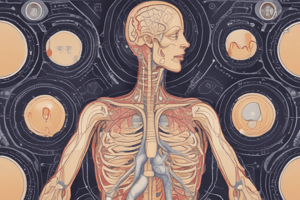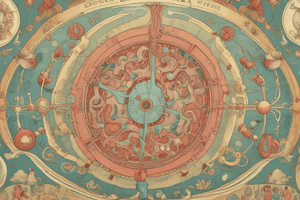Podcast
Questions and Answers
What distinguishes the endocrine system from the nervous system in terms of control?
What distinguishes the endocrine system from the nervous system in terms of control?
- The endocrine system requires direct nerve impulses.
- The endocrine system is ducted.
- The endocrine system is more rapid in action.
- The endocrine system uses hormones for prolonged effects. (correct)
Which of the following is NOT considered a purely endocrine organ?
Which of the following is NOT considered a purely endocrine organ?
- Pituitary gland
- Pineal gland
- Pancreas (correct)
- Thyroid gland
How do steroid hormones primarily influence cellular responses?
How do steroid hormones primarily influence cellular responses?
- By increasing cyclic AMP concentration in the cells.
- By directly altering DNA and initiating protein synthesis. (correct)
- By activating enzymes within the cytoplasm.
- By binding to membrane receptors and activating G proteins.
Which type of hormone is characterized as water soluble?
Which type of hormone is characterized as water soluble?
What role do second messengers play in hormone action?
What role do second messengers play in hormone action?
Which of the following statements about the hypothalamus is correct?
Which of the following statements about the hypothalamus is correct?
Which of the following is a common second messenger used by amino acid-based hormones?
Which of the following is a common second messenger used by amino acid-based hormones?
What is the primary function of autocrines in the body?
What is the primary function of autocrines in the body?
What hormone is primarily responsible for regulating blood calcium levels?
What hormone is primarily responsible for regulating blood calcium levels?
Which condition is characterized by extremely low blood calcium levels leading to symptoms like tetany?
Which condition is characterized by extremely low blood calcium levels leading to symptoms like tetany?
Which hormone is primarily produced by the adrenal cortex that regulates sodium and potassium levels?
Which hormone is primarily produced by the adrenal cortex that regulates sodium and potassium levels?
What stimulates the release of glucocorticoids from the adrenal cortex?
What stimulates the release of glucocorticoids from the adrenal cortex?
Which of the following is NOT a function of melatonin secreted by the pineal gland?
Which of the following is NOT a function of melatonin secreted by the pineal gland?
What is the primary effect of catecholamines such as epinephrine and norepinephrine produced by the adrenal medulla?
What is the primary effect of catecholamines such as epinephrine and norepinephrine produced by the adrenal medulla?
What type of feedback is essential in regulating hormone levels in the bloodstream?
What type of feedback is essential in regulating hormone levels in the bloodstream?
Which hormone released by the pancreas decreases blood sugar levels?
Which hormone released by the pancreas decreases blood sugar levels?
Which hormone is secreted by the ovaries and is crucial for the female reproductive system's maturation?
Which hormone is secreted by the ovaries and is crucial for the female reproductive system's maturation?
Which organs are primarily responsible for degrading hormones in the body?
Which organs are primarily responsible for degrading hormones in the body?
What condition results from hypersecretion of adrenal cortex hormones?
What condition results from hypersecretion of adrenal cortex hormones?
What role does permissiveness play in hormonal interaction?
What role does permissiveness play in hormonal interaction?
How does the hypothalamus influence the anterior pituitary's hormone output?
How does the hypothalamus influence the anterior pituitary's hormone output?
Which of the following organs is considered a non-endocrine source of hormone secretion?
Which of the following organs is considered a non-endocrine source of hormone secretion?
What triggers the adrenal cortex to release aldosterone?
What triggers the adrenal cortex to release aldosterone?
What is the effect of antidiuretic hormone (ADH) on the kidneys?
What is the effect of antidiuretic hormone (ADH) on the kidneys?
Which hormone is primarily responsible for stimulating uterine contractions during labor?
Which hormone is primarily responsible for stimulating uterine contractions during labor?
What hormonal change characterizes the onset of menopause in women?
What hormonal change characterizes the onset of menopause in women?
Which gland declines in size and function with age, impacting the immune response?
Which gland declines in size and function with age, impacting the immune response?
What condition is a result of hyposecretion of growth hormone in children?
What condition is a result of hyposecretion of growth hormone in children?
What is the main metabolic effect of thyroid hormones?
What is the main metabolic effect of thyroid hormones?
What does hypersecretion of thyroid hormones lead to?
What does hypersecretion of thyroid hormones lead to?
What is the primary function of prolactin (PRL) in humans?
What is the primary function of prolactin (PRL) in humans?
What hormone inhibits the release of prolactin?
What hormone inhibits the release of prolactin?
What hormone stimulates the adrenal cortex to release corticosteroids?
What hormone stimulates the adrenal cortex to release corticosteroids?
Which part of the thyroid gland produces calcitonin?
Which part of the thyroid gland produces calcitonin?
Flashcards
What are the two major controlling systems of the body?
What are the two major controlling systems of the body?
The endocrine system is one of the body's two major control systems, responsible for slower, long-lasting effects using hormones.
What are hormones and what are they responsible for?
What are hormones and what are they responsible for?
Hormones are chemical messengers that regulate various bodily functions like reproduction, growth, metabolism, and immune responses.
What are endocrine glands and what are some examples?
What are endocrine glands and what are some examples?
Endocrine glands are ductless organs that release hormones directly into the bloodstream or lymph. They are small, scattered throughout the body, and include the pituitary, thyroid, parathyroid, adrenal, and pineal glands.
How do the chemical structures of hormones affect their behavior?
How do the chemical structures of hormones affect their behavior?
Signup and view all the flashcards
How do hormones affect target cells?
How do hormones affect target cells?
Signup and view all the flashcards
What is a second messenger system in hormone action?
What is a second messenger system in hormone action?
Signup and view all the flashcards
How do steroid hormones and thyroid hormone affect cellular function?
How do steroid hormones and thyroid hormone affect cellular function?
Signup and view all the flashcards
What are autocrines and paracrines?
What are autocrines and paracrines?
Signup and view all the flashcards
Parathyroid hormone (PTH)
Parathyroid hormone (PTH)
Signup and view all the flashcards
Hyperparathyroidism
Hyperparathyroidism
Signup and view all the flashcards
Hypoparathyroidism
Hypoparathyroidism
Signup and view all the flashcards
Adrenal Cortex
Adrenal Cortex
Signup and view all the flashcards
Mineralocorticoids
Mineralocorticoids
Signup and view all the flashcards
Aldosterone
Aldosterone
Signup and view all the flashcards
Glucocorticoids
Glucocorticoids
Signup and view all the flashcards
Cortisol
Cortisol
Signup and view all the flashcards
Gonadocorticoids
Gonadocorticoids
Signup and view all the flashcards
Adrenal Medulla
Adrenal Medulla
Signup and view all the flashcards
Catecholamines
Catecholamines
Signup and view all the flashcards
Melatonin
Melatonin
Signup and view all the flashcards
Pancreas
Pancreas
Signup and view all the flashcards
Insulin
Insulin
Signup and view all the flashcards
Glucagon
Glucagon
Signup and view all the flashcards
What are the three types of stimuli that cause hormone release?
What are the three types of stimuli that cause hormone release?
Signup and view all the flashcards
What is negative feedback in hormone regulation?
What is negative feedback in hormone regulation?
Signup and view all the flashcards
What determines a cell's response to a hormone?
What determines a cell's response to a hormone?
Signup and view all the flashcards
What is the half-life of a hormone?
What is the half-life of a hormone?
Signup and view all the flashcards
What is permissiveness in hormone interaction?
What is permissiveness in hormone interaction?
Signup and view all the flashcards
What is synergism in hormone interaction?
What is synergism in hormone interaction?
Signup and view all the flashcards
What is antagonism in hormone interaction?
What is antagonism in hormone interaction?
Signup and view all the flashcards
What is the pituitary gland?
What is the pituitary gland?
Signup and view all the flashcards
What is the role of the posterior pituitary?
What is the role of the posterior pituitary?
Signup and view all the flashcards
What is oxytocin?
What is oxytocin?
Signup and view all the flashcards
What is antidiuretic hormone (ADH)?
What is antidiuretic hormone (ADH)?
Signup and view all the flashcards
What is the role of the anterior pituitary?
What is the role of the anterior pituitary?
Signup and view all the flashcards
What is growth hormone (GH)?
What is growth hormone (GH)?
Signup and view all the flashcards
What is thyroid-stimulating hormone (TSH)?
What is thyroid-stimulating hormone (TSH)?
Signup and view all the flashcards
What is adrenocorticotropic hormone (ACTH)?
What is adrenocorticotropic hormone (ACTH)?
Signup and view all the flashcards
Study Notes
Endocrine System Overview
- The endocrine and nervous systems are the body's major control systems.
- The nervous system uses rapid nerve impulses, while the endocrine system uses hormones for prolonged effects.
- Hormonal regulation controls various processes, including: reproduction, growth/development, electrolyte/water/nutrient balance, cellular metabolism/energy balance, and immune responses.
- Endocrine organs are ductless, well-vascularized glands.
- Purely endocrine organs include pituitary, thyroid, parathyroid, adrenal, and pineal glands. The hypothalamus is a neuroendocrine organ.
- Other organs with endocrine tissue include pancreas, gonads, and placenta.
- Local chemical messengers (autocrines and paracrines) are not considered part of the endocrine system.
Hormone Chemical Structure and Action
- Most hormones are either steroids or amino acid-based.
- Steroid hormones are lipid-soluble.
- All amino acid-based hormones are water-soluble, except thyroid hormone.
- Hormones alter target cell activity by influencing membrane permeability, enzyme action, secretory activity, and mitosis.
Hormone Action Mechanisms
- Amino acid-based hormones usually act via second messenger systems (e.g., cAMP, calcium).
- These systems involve a hormone binding to a receptor, activating a G-protein, which leads to enzyme activity and cellular responses.
- Steroid hormones and thyroid hormone act by entering cells and directly activating DNA, triggering protein synthesis.
Hormone Release Stimuli
- Hormone release is controlled by humoral, neural, or hormonal stimuli.
- Negative feedback is crucial for regulating hormone levels.
- The nervous system (through the hypothalamus) can influence hormonal responses.
Hormone Target Cell Response
- Target cells respond to a hormone only if they have a receptor for that hormone.
- Receptor numbers and sensitivity can change based on hormone levels.
- Hormone levels depend on secretion and degradation/excretion rates.
- The liver and kidneys are key hormone-degrading and excreting organs.
- Hormonal half-lives and durations vary.
Hormonal Interactions
- Permissiveness: One hormone enables another to fully exert its effect.
- Synergism: Multiple hormones amplify each other's effects.
- Antagonism: One hormone opposes or reverses another's effects.
Hypothalamus and Pituitary Gland
- The pituitary gland is a dual-structure organ (anterior and posterior).
- The hypothalamus controls anterior pituitary hormone release through releasing and inhibiting hormones.
- Posterior pituitary stores and releases oxytocin and antidiuretic hormone (ADH), produced by the hypothalamus.
- Oxytocin stimulates uterine contractions and milk ejection.
- ADH regulates water reabsorption in the kidneys.
- Anterior pituitary hormones:
- Growth hormone (GH): Stimulates growth; regulated by GHRH and GHIH. Imbalances lead to gigantism, acromegaly, or pituitary dwarfism.
- Thyroid-stimulating hormone (TSH): Regulates thyroid function; regulated by TRH.
- Adrenocorticotropic hormone (ACTH): Controls adrenal cortex function; regulated by CRH.
- Gonadotropins (FSH and LH): Regulate gonadal function; regulated by GnRH.
- Prolactin (PRL): Stimulates milk production; regulated by PIH.
Thyroid Gland
- The thyroid gland produces thyroxine (T4) and triiodothyronine (T3), which increase metabolic rate.
- These hormones act via gene transcription.
- Disorders include Graves' disease (hyperthyroidism) and myxedema (hypothyroidism).
- Calcitonin (produced by parafollicular cells) is not majorly involved in calcium homeostasis.
Parathyroid Glands
- Parathyroid hormone (PTH) increases blood calcium levels.
- Targets bone, kidneys, and intestine (via vitamin D).
- Imbalances lead to hypercalcemia or hypocalcemia.
Adrenal Glands
- The adrenal glands consist of cortex and medulla.
- Adrenal cortex: produces steroid hormones:
- Mineralocorticoids (aldosterone): Regulates electrolyte balance.
- Glucocorticoids (cortisol): Regulates metabolism and stress response.
- Gonadocorticoids (androgens): Sex hormones.
- Adrenal medulla: produces catecholamines (epinephrine and norepinephrine) in response to stress.
Pineal Gland
- The pineal gland secretes melatonin, which influences daily rhythms.
Other Hormone-Producing Organs
- Pancreas: Produces insulin (lowers blood glucose) and glucagon (raises blood glucose). Diabetes mellitus results from imbalances.
- Gonads (ovaries and testes): Produce sex hormones (estrogens/progesterone in females; testosterone in males), regulating sexual development and function.
- Placenta: Produces hormones during pregnancy (estrogens, and progesterone).
- Other organs (heart, gastrointestinal tract, kidneys, skin, adipose tissue, bone, thymus) also produce hormones playing important roles.
Developmental Aspects
- Endocrine glands develop from different germ layers.
- Menopause is a natural decline in ovarian function.
- Endocrine function decreases with aging.
Studying That Suits You
Use AI to generate personalized quizzes and flashcards to suit your learning preferences.




